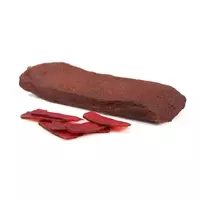Pastrami

Basturma, which is a cured tenderloin of beef meat, came to us from the states in which the former Ottoman Empire was located. Interestingly, today there are several versions of the origin of this product, but only two of them deserve special attention in view of their possible reliability.
According to the first legend, the basturm owes its emergence to the courageous soldiers of Genghis Khan, who took with them considerable supplies of provisions on military campaigns. It is clear that meat was on the list of necessary products. In order to prevent the meat product from spoiling, it was cut with thin slices and put under the saddle of the horse. There it drained perfectly then ungulate, and excess moisture went away due to the weight of the saddle and rider.
According to a second source, the first mention of basturm dates back to as early as BC - namely 95-94, when Armenia was ruled by the majestic king Tigran Mes. He sought to expand his possessions, so he actively developed trade and culture. The caravans of merchants followed to distant countries, but taking meat with them on such long trips was simply not possible, because on the second day it began to deteriorate. So it is believed that it was then that the technology of beef drying was invented. Thus, meat not only retained most of the beneficial qualities, but also surprised its unusual taste.
Like many centuries ago, the basturma prepared today is distinguished by a subtle exquisite taste and fragrant aroma. The calorie content of the basturm is 240 kcal per 100 grams. Undoubtedly, you can buy this appetising product in most of our stores, but many gourmet craftsmen are not lazy to make this dish with their own hands. Even despite the rather painstaking and time-consuming process.
First of all, suitable meat is chosen to prepare basturma - the cutting and pulp of the back of the animal's carcass is considered an ideal option. It is cut into pieces, the thickness of which should not exceed six centimeters. These beds are laid in rows, while they are thoroughly poured with salt. The future basturma is then wrapped in a dense cloth and left for four days. Moreover, after a couple of days, the pieces of meat are necessarily turned over.
At the next stage, excess salt is thoroughly washed off, and the meat is dried with napkins, after which it is tightly swaddled in gauze and placed under the load for another half day. After pressing, the meat is tightly tied with twine and hung to ventilate the watch for 1
2. The most interesting, and we can say the final stage, is considered the process of coating basturma with a mixture based on various spices and water. After being smeared three times, the beef is dried for at least a week to keep the meat dry inside. In general, the preparation of this product is quite complicated, but the pleasure gained from eating basturma is hardly comparable to the pleasure of other food.
basturms 240 kKal
Energy value of basturma (Ratio of proteins, fats, carbohydrates - ju):
Proteins: 14.8 (~ 59 kCal)
Fats: 20.1 g (~ 181 kCal)
Carbohydrates: 0 g (~ 0 kCal)
Energy ratio (b | y): 25% | 75% | 0%
 Español
Español Français
Français Português
Português Русский
Русский 简体中文
简体中文 繁體中文
繁體中文 日本語
日本語 한국어
한국어 العربية
العربية Türkçe
Türkçe Қазақ
Қазақ Deutsch
Deutsch Italiano
Italiano Українська
Українська
